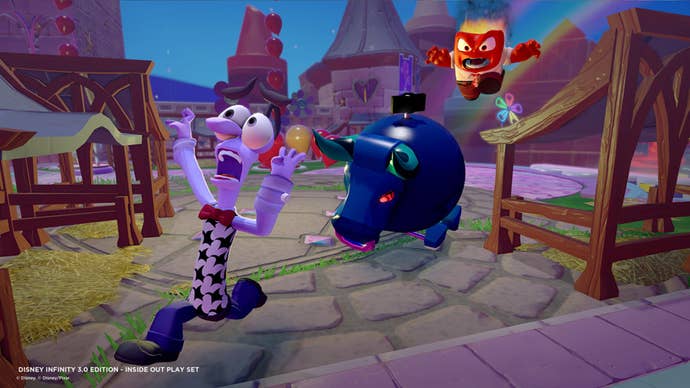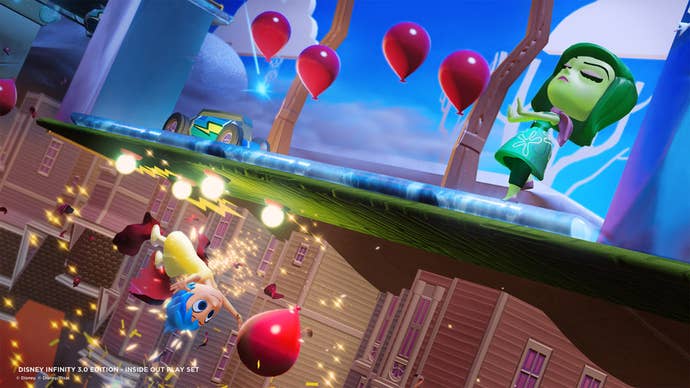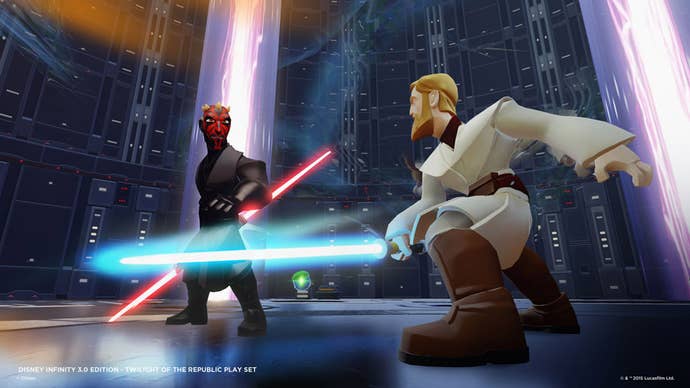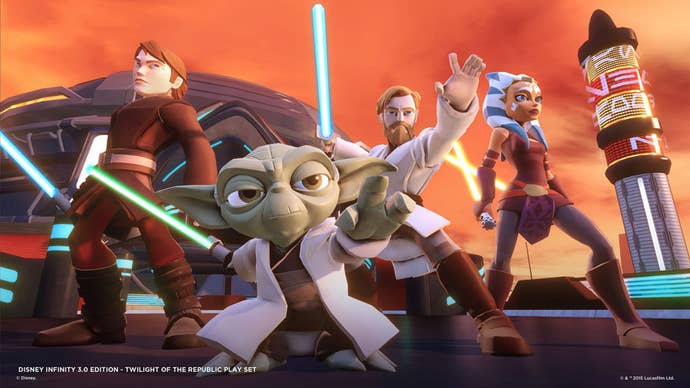Disney Infinity 3.0 Wii U Review: Chewbacca-Sized Fun, Han Solo-Sized Debt
Disney's latest toys-to-life endeavor is a messy, awkward, glorious nostalgia trip. But what price fond memories?
This article first appeared on USgamer, a partner publication of VG247. Some content, such as this article, has been migrated to VG247 for posterity after USgamer's closure - but it has not been edited or further vetted by the VG247 team.
When I previewed Disney Infinity 3.0's Rise Against the Empire playset back at E3, I was thrilled to discover I could drive Luke Skywalker's Landspeeder from Mos Eisley spaceport all the way out into the desert. There, I steered it immediately into the Sarlaac's maw, doing a Grand Theft Auto-style bail-out shortly before the vehicle went over the precipice to be digested, slowly, over a thousand years.
I was curious to see what would happen. The answer, it turns out, is that the antlion-like creature found Luke's ride considerably less palatable than its silver-screen counterpart did Boba Fett. After a few seconds of quivering in disgust, the Sarlacc puked the vehicle back to the surface in a geyser of monster vomit.
In the final game, you can do the same thing. The Sarlaac barf is a dull greyish-white now rather than the revolting diaper green of the pre-launch demo, but the mechanic itself hasn't changed. This time around, however, you don't need to go out of your way to find things to chuck into the Sarlaac pit. The game designers have considerately populated the area next to the Sarlaac with a few random Jawas, including one standing idly on a small rise looking over the toothy expanse of the creatures orifice. You can pick up these Jawas; you can also toss them. The message is clear: "We know you guys are going to abuse the Sarlaac, so we've made it easy for you."
This neatly encapsulates the general experience of playing Disney Infinity 3.0—and not just the classic Star Wars mode. Disney uses terms like "toy box" and "play set" to describe elements of Infinity, and these turns of phrase map quite accurately onto the game itself. At every turn, Infinity feels like a big collection of toys jumbled into a pile on the floor, offering players the freedom to approach it however they want while simultaneously trying to predict their choices and accommodate them.

The "jumbled heap" sensation isn't strictly metaphorical in this case, though. It tends to be quite literal, as the entire concept of Infinity revolves around Skylanders-like toys. The most obvious difference between the two franchises, of course, comes from Disney's ravenous hunger for brand acquisitions: Besides classic Disney/Pixar characters, Infinity also makes use of the corporation's extensive list of characters and properties. Last year's emphasis sat squarely on Marvel super heroes, while this year's play sets unsurprisingly centers around Star Wars.
Infinity is as much a game as a marketing tool, timed with impressive precision to deliver maximum sales impact. The initial package shipped with kid-friendly Star Wars characters (Anakin Skywalker and Ahsoka Tano, who look almost identical to their Clone Wars versions when rendered in Infinity's chunky art style); classic original trilogy content and characters shipped a few weeks after that; and the whole thing comes to a head in December with a Force Awakens play set timed to arrive the day the film debuts.
Infinity 3.0 doesn't center on Star Wars to the absolute exclusion of all else; roughly half the new figures this year hail from other properties. The game's treatment of its assorted franchise source material has a lot to do with the overall package's haphazard feeling, however; the grab bag of new characters feels perplexing at best. Currently, the only non-Star Wars property to be given the full Infinity 3.0 play set treatment is Pixar's Inside Out; meanwhile, Disney has added Fa Mulan, a couple of Tron Legacy characters, and both Mickey and Minnie Mouse, yet doesn't really offer a compelling use for any of them outside the Toy Box Takeover expansion. Tron characters I can understand being left out in the cold—just like the film franchise!—but Mickey and Minnie are kind of big deals in the Disney universe. Nevertheless, there's no story mode for them, and all of these figurines just amount to generic, interchangeable skins for some of the free-play modes.

Much of this comes down to the unintuitive and restrictive way Infinity handles its play sets. The game imposes hard limits on which characters can be used in each story expansion. Star Wars play sets will only allow you to use your Star Wars toys; so no, don't expect to see Otis the Snowman take on General Grievous, or Minnie Mouse blow up the Death Star. You even have to earn permission if you simply want to mix-and-match eras by finding hidden token that allow you to unlock toys from a different portion of the Star Wars timeline. The Inside Out playset is even more limiting, allowing you to play strictly as one of the film's five "emotion" characters.
No doubt this has to do with licensing rules—Disney Interactive may be a part of the same big, happy family as Pixar and LucasFilm, but each division is its own little fiefdom. But given how much it costs to buy-in to Infinity, and how much you can potentially spend on toys and play sets, these barriers chafe. It's tough enough to swallow the fact that the $100 worth of interactive Star Wars characters you bought won't work with the $35 Inside Out play set despite their being components of the same game, but I found it even worse trying to explain to my five-year-old nephew that he couldn't use the Chewbacca figure he loved so much when playing through Inside Out.
Speaking of my nephew, his bewilderment over Infinity's interface also helped me appreciate just what a clumsy, unintuitive piece of software the game is. For a product that makes a pretty solid bid for being genuinely "all ages," Infinity does not make itself friendly to younger players. Entire modes fail to appear as an option unless you place the requisite toy on the game portal, and even then they show up as tiny menu options. Infinity's central interface design hinges on an ugly, cramped text menu that's completely opaque to young players... and pretty lousy for older ones as well. While the overall package is very much a modern, current-day console release, its user interface feels like a PC game circa 1996.

All of these factor create a steep and frankly frustrating barrier to entry for Infinity, so it's a good thing the game can rely on its popular licenses to coax players past those initial speedbumps. Get beyond the restrictions and inconveniences of Infinity 3.0 and you'll find it offers a huge variety of play formats, all rendered with remarkable grace. Of course, you'd really expect no less from the game; Disney rounded up something of an all-star developer cast here, including Ninja Theory on the core action and Sumo Digital on the driving. The effort paid off: Infinity plays well in all areas. Sure, it's low-friction kid-friendly action, but it feels a lot more substantial than most other family-oriented games, e.g. the LEGO franchise. Fighting has weight, and characters possess a variety of different attacks. The racing feels considerably more substantial than the driving portions of Skylanders: Superchargers, too. That's pretty impressive considering that vehicles feel like more of a sort of obligatory "sure, why not" addition in Infinity than the key selling point they constitute for Superchargers.
What most I find more remarkable about Infinity's gameplay is the fact that it all covers such a wide spread of styles. The "jumble of toys" aspect can make Infinity hard to approach, especially the open-ended Toy Box mode, but once you make it past the initial awkwardness of clunky menus and unintuitive requirements, it really does manage to become one of those rare creations that tries to be all things to all people and largely pulls it off. The Inside Out expansion combines 3D and 2D platforming in equal measures, while the Star Wars modes alternate between surprisingly large sandbox areas and structured missions. While none of these elements manage to be top of their class (I've certainly played through better attacks on the Death Star, for example), at the worst they're still totally competent. At their best, they're seriously addictive. There's something to be said for farting around familiar locales like Mos Eisley or Echo Base, totally carefree—an opportunity I've never seen in any of the many other Star Wars games I've ever played.
Infinity thoughtfully offers players the freedom to return to their favorite sequences at any time (provided they stick the right widget on the portal, of course). You can jump out of the linear progression of the different story modes and return to old locations to find collectibles and complete missions, or simply to let someone with different tastes enjoy the areas they enjoy most. The adaptability and variety Infinity offers manages to overcome its catastrophically poor front-end design.

Of course, all of this comes at a price. Infinity as a core product is basically an unstructured world that requires various pricey plastic trophies if you want to delve into anything more meaningful. Not to knock the default Toy Box mode—it's somewhere in scope and design between My First Grand Theft Auto and a stripped-down Project Spark, giving players the freedom to build toys and challenges or simply goof around. Much as my nephew enjoyed the Inside Out stages and fighting random Hoth Wampas, he actually had the most fun using Yoda to commandeer the bed from Bedknobs & Broomsticks and fly around aimlessly through the procedurally generated Toy Box world.
And therein lies much of the appeal of Infinity: It lets you throw all kinds of beloved characters and worlds together—within certain limits, of course. At age five, my nephew has only barely discovered Yoda and Chewbacca, and he certainly doesn't have the first clue as to what Bedknobs & Broomsticks is (a movie that was already fading to obscurity back when I was his age). But while the flying bed is just one of the seemingly endless random elements you can unlock in Toy Box mode, Yoda and Chewie are sold separately. So, too, are all the story expansions beyond the packed-in Twilight of the Republic set. All told, it appears Infinity 3.0 will receive four expansions in total (two Star Wars, Inside Out, and an unspecified Marvel set), along with dongles that unlock the racing sub-game and a series of structured conflicts for the Toy Box.

The total bill for just the base content and 10 packed-in figures alone comes to nearly $250, and that doesn't even get into the cost of all the dozens of extra figures introduced with Infinity 3.0. It's a hefty commitment, and unlike Skylanders, the starter kit doesn't include all the primary content. There are also $50 worth of cosmetic add-ons as well, for the serious addicts in the audience.
The saving grace, ultimately, comes in the fact that despite its heavy emphasis on collection, Infinity's actual game mechanics encourage specialization with just a few favorite characters. Per usual, each figure you buy has its own built-in data storage that allows it to retain experience, levels, and skill tree perk selections. It takes the better part of a story expansion playthrough to bring a character to their level cap, so it's actually to your disadvantage to juggle multiple figures. If not for the barriers preventing you from breaking Star Wars canon and defeating dark side Force users with Inside Out's Fear and Anger, you could just main a single character and rarely have to swap. As it is, you can easily build a small team of specialists for each franchise (a tech character for hacking, a melee user for close combat, a ranged attacker for shooting down bonus Mynocks in the Star Wars packs) and do just fine. While the expansion packs feel mandatory, Infinity's additional figures are more like suggestions, or options, so players can pick up their personal favorites. And it really is better to just pick out a handful of favorites. There's a hefty buy-in however you play, but for the most part Infinity 3.0 is worth the price. It's fun, and it actually does work for players of all ages—a feat many have attempted, but few achieve.
InterfaceProbably the worst front-end I've seen all decade. And no button remapping. And all those plastic toys and disks to keep up with...
Lasting AppealThe individual expansions are worth about 10 hours of play, but the basic Toy Box mode has the long-term appeal of a open-ended construction sandbox.
SoundWay too chatty, way to nagging. Great music, though, and spot-on sound effects.
VisualsThe Pixar-like Infinity art style brings a lot of disparate franchises together. It looks solid even on the older consoles, though it runs more smoothly on PS4 and Xbox One.
ConclusionDisney Infinity suffers from some very short-term flaws (that interface, ugh!) and long-term challenges (the price of the game adds up quickly). If you're willing to grapple with those issues, however, you'll find an excellent, expansive, and remarkably well-crafted action game brimming with variety. Dabbling in nearly every genre imaginable in addition to its baseline sandbox mode, Infinity 3.0 has appeal for players both young and old—that is, whether you grew up with Luke Skywalker or just cut your teeth on Anakin and Ahsoka.








